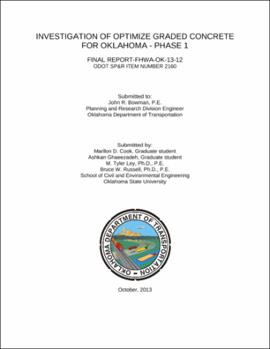| dc.creator | Cook, Marllon | |
| dc.creator | Ghaeezadeh, Ashkan | |
| dc.creator | Ley, Tyler | |
| dc.creator | Russell, Bruce | |
| dc.date.accessioned | 2018-03-01T20:50:09Z | |
| dc.date.available | 2018-03-01T20:50:09Z | |
| dc.date.issued | 2013-10 | |
| dc.identifier.govdoc | FHWA-OK-13-12 | |
| dc.identifier.other | Oklahoma Department of Transportation State Planning and Research item number 2160 | |
| dc.identifier.uri | https://hdl.handle.net/11244/54452 | |
| dc.description.abstract | Optimized Graded Concrete has been a subject widely discussed through the history of concrete. Since aggregates make up over 70% of the volume in a mixture, gradation is critical to the strength, workability, and durability of concrete. In practice only a small quantitative guidance can be given to practitioners on aggregate proportioning in a mixture to meet the desired performance. The ACI 211 Mixture Design Procedure maybe the most widely taught mixture design method, but still is not widely used in practice due to the impracticality. In fact the ACI 211 method only contains a handful of aggregate parameters that many argue about the validity. One of the largest obstacles preventing the development of aggregate parameters and guidance comes from only a few test methods have been able to provide quantitative data about the workability of concrete. This work focused on creating a practical test method and using it to better understand the aggregate gradation impacts on the workability of concrete. In this report a new workability test for concrete was developed to investigate mixtures for slip formed pavements. This was done by creating a test called the “Box Test” in Chapter 2. The Box Test was then used to evaluate several existing optimized graded design methods in Chapter 3. After finding some shortcomings in the current methods, Chapter 4 develops a new set of design recommendations and specifications. Finally, Chapter 5 investigates the durability of the optimized graded mixtures in freeze thaw and shrinkage testing. The ultimate product of this work is a new specification for the state of Oklahoma for mixtures with a greater durability at reduced cost and with improved sustainability. Based on 2013 production this design method has the potential to save the state of Oklahoma over $4 million per year and long term costs through reduced maintenance from durability issues and the reduced amount of cement paste needed to make satisfactory mixtures. | |
| dc.format.extent | 218 pages | |
| dc.format.extent | 3,111,718 bytes | |
| dc.format.medium | application.pdf | |
| dc.language | en_US | |
| dc.relation.ispartofseries | No | |
| dc.relation.requires | Adobe Acrobat Reader | |
| dc.title | INVESTIGATION OF OPTIMIZE GRADED CONCRETE FOR OKLAHOMA - PHASE 1 (FHWA-OK-13-12 2160) | |
| dc.type | Technical Report | |
| dc.description.version | Final Report, October 2011-October 2013 | |
| dc.description.peerreview | No | |
| dc.type.material | text | |
| dc.subject.keywords | Optimized graded concrete | |
| dc.subject.keywords | aggregate gradation | |
| dc.contributor.sponsor | Oklahoma Department of Transportation. Materials and Research Division. Office of Research & Implementation | |
